CRAN Energy Efficiency: Resource Allocation Report and Analysis
VerifiedAdded on 2023/06/05
|11
|4446
|365
Report
AI Summary
This report addresses the challenge of minimizing energy consumption in Cloud Radio Access Networks (CRAN) while meeting user task constraints. It introduces a system model designed to enhance resource allocation management within the CRAN environment, aiming to reduce wireless network congestion. The core of the approach is a resource allocation algorithm that efficiently manages network resources, thereby reducing power consumption. Key performance indicators are evaluated to balance the load on fronthaul and backhaul interlinks between network units. The proposed algorithm focuses on reducing power consumption by network resources to improve utility and efficiency. The report details the energy consumption model, system architecture, and the resource allocation algorithm, presenting numerical results and concluding remarks. It also discusses challenges in CRAN queue model development, such as synchronization delays and interference, and suggests strategies for optimizing resource allocation in wireless environments.
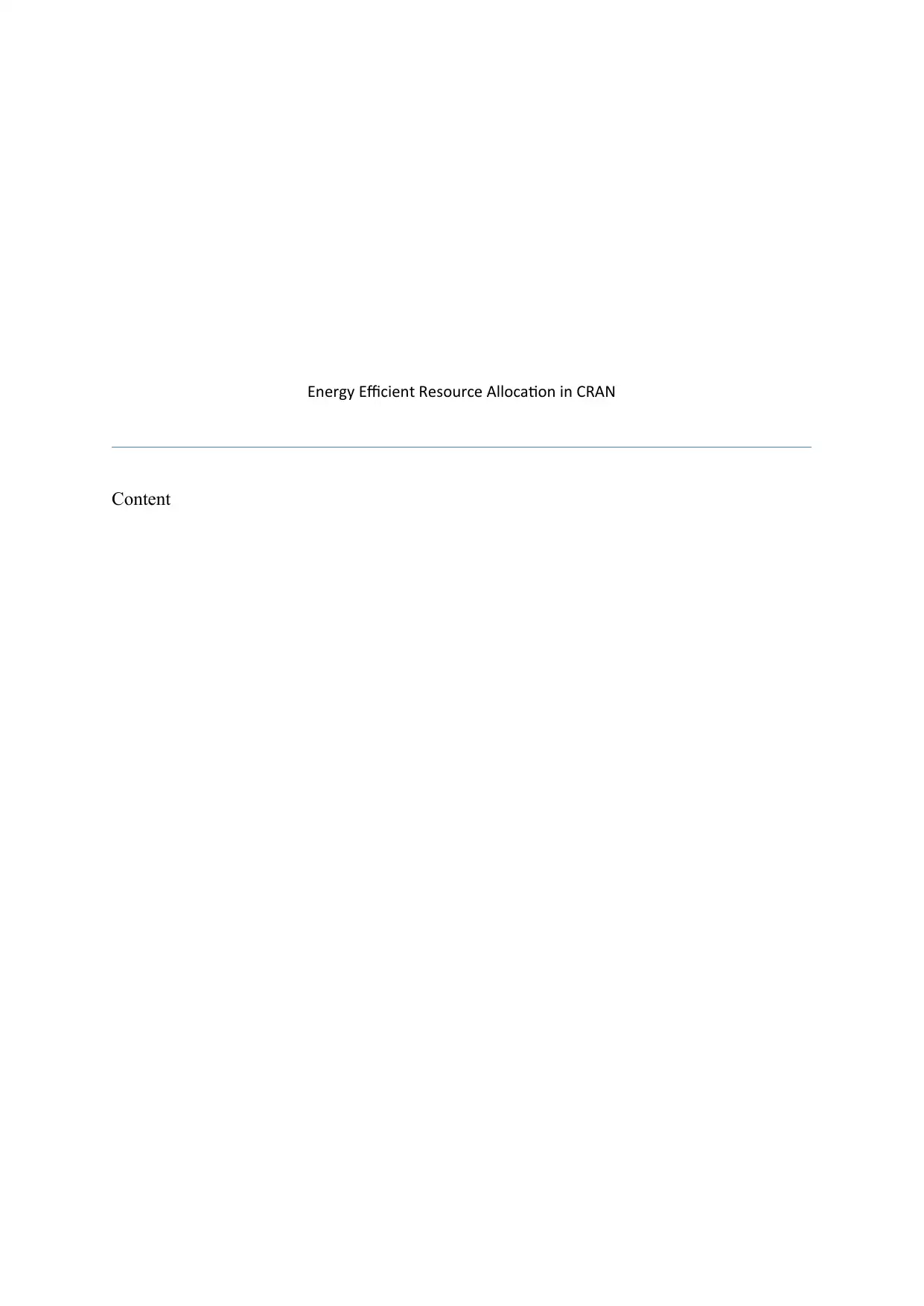
Energy Efficient Resource Allocation in CRAN
Content
Content
Paraphrase This Document
Need a fresh take? Get an instant paraphrase of this document with our AI Paraphraser
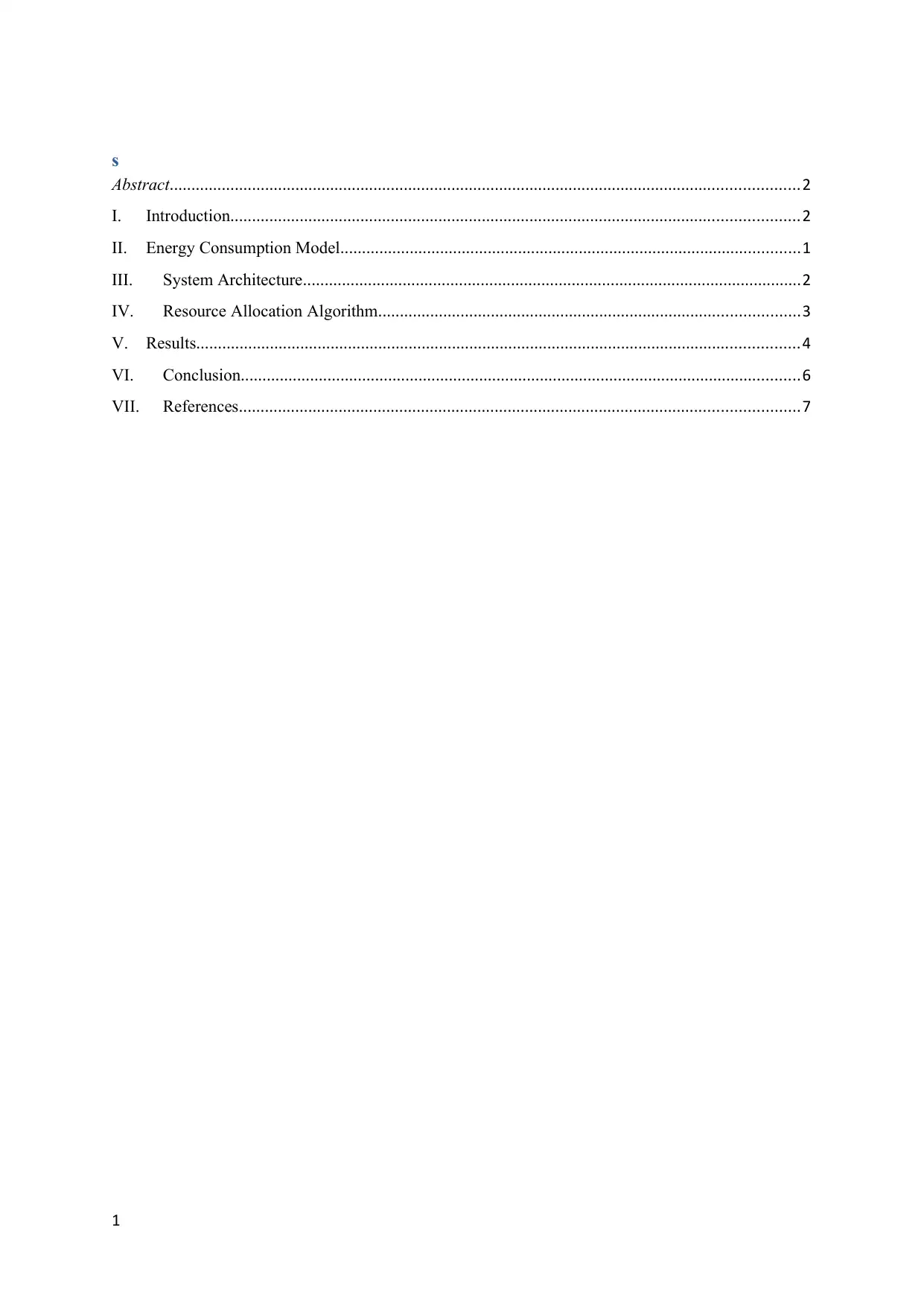
s
Abstract.................................................................................................................................................2
I. Introduction...................................................................................................................................2
II. Energy Consumption Model..........................................................................................................1
III. System Architecture...................................................................................................................2
IV. Resource Allocation Algorithm.................................................................................................3
V. Results...........................................................................................................................................4
VI. Conclusion.................................................................................................................................6
VII. References.................................................................................................................................7
1
Abstract.................................................................................................................................................2
I. Introduction...................................................................................................................................2
II. Energy Consumption Model..........................................................................................................1
III. System Architecture...................................................................................................................2
IV. Resource Allocation Algorithm.................................................................................................3
V. Results...........................................................................................................................................4
VI. Conclusion.................................................................................................................................6
VII. References.................................................................................................................................7
1
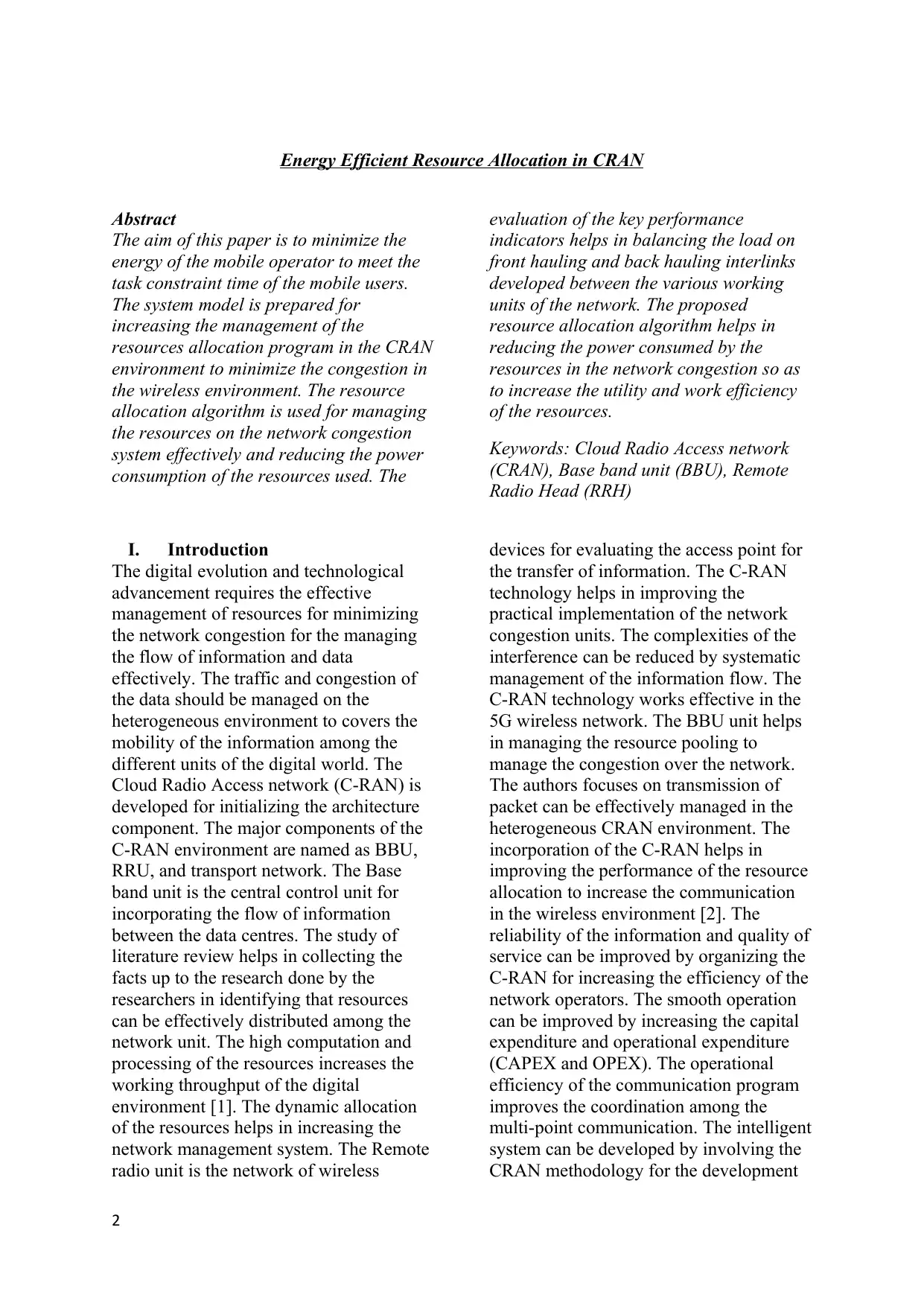
Energy Efficient Resource Allocation in CRAN
Abstract
The aim of this paper is to minimize the
energy of the mobile operator to meet the
task constraint time of the mobile users.
The system model is prepared for
increasing the management of the
resources allocation program in the CRAN
environment to minimize the congestion in
the wireless environment. The resource
allocation algorithm is used for managing
the resources on the network congestion
system effectively and reducing the power
consumption of the resources used. The
evaluation of the key performance
indicators helps in balancing the load on
front hauling and back hauling interlinks
developed between the various working
units of the network. The proposed
resource allocation algorithm helps in
reducing the power consumed by the
resources in the network congestion so as
to increase the utility and work efficiency
of the resources.
Keywords: Cloud Radio Access network
(CRAN), Base band unit (BBU), Remote
Radio Head (RRH)
I. Introduction
The digital evolution and technological
advancement requires the effective
management of resources for minimizing
the network congestion for the managing
the flow of information and data
effectively. The traffic and congestion of
the data should be managed on the
heterogeneous environment to covers the
mobility of the information among the
different units of the digital world. The
Cloud Radio Access network (C-RAN) is
developed for initializing the architecture
component. The major components of the
C-RAN environment are named as BBU,
RRU, and transport network. The Base
band unit is the central control unit for
incorporating the flow of information
between the data centres. The study of
literature review helps in collecting the
facts up to the research done by the
researchers in identifying that resources
can be effectively distributed among the
network unit. The high computation and
processing of the resources increases the
working throughput of the digital
environment [1]. The dynamic allocation
of the resources helps in increasing the
network management system. The Remote
radio unit is the network of wireless
devices for evaluating the access point for
the transfer of information. The C-RAN
technology helps in improving the
practical implementation of the network
congestion units. The complexities of the
interference can be reduced by systematic
management of the information flow. The
C-RAN technology works effective in the
5G wireless network. The BBU unit helps
in managing the resource pooling to
manage the congestion over the network.
The authors focuses on transmission of
packet can be effectively managed in the
heterogeneous CRAN environment. The
incorporation of the C-RAN helps in
improving the performance of the resource
allocation to increase the communication
in the wireless environment [2]. The
reliability of the information and quality of
service can be improved by organizing the
C-RAN for increasing the efficiency of the
network operators. The smooth operation
can be improved by increasing the capital
expenditure and operational expenditure
(CAPEX and OPEX). The operational
efficiency of the communication program
improves the coordination among the
multi-point communication. The intelligent
system can be developed by involving the
CRAN methodology for the development
2
Abstract
The aim of this paper is to minimize the
energy of the mobile operator to meet the
task constraint time of the mobile users.
The system model is prepared for
increasing the management of the
resources allocation program in the CRAN
environment to minimize the congestion in
the wireless environment. The resource
allocation algorithm is used for managing
the resources on the network congestion
system effectively and reducing the power
consumption of the resources used. The
evaluation of the key performance
indicators helps in balancing the load on
front hauling and back hauling interlinks
developed between the various working
units of the network. The proposed
resource allocation algorithm helps in
reducing the power consumed by the
resources in the network congestion so as
to increase the utility and work efficiency
of the resources.
Keywords: Cloud Radio Access network
(CRAN), Base band unit (BBU), Remote
Radio Head (RRH)
I. Introduction
The digital evolution and technological
advancement requires the effective
management of resources for minimizing
the network congestion for the managing
the flow of information and data
effectively. The traffic and congestion of
the data should be managed on the
heterogeneous environment to covers the
mobility of the information among the
different units of the digital world. The
Cloud Radio Access network (C-RAN) is
developed for initializing the architecture
component. The major components of the
C-RAN environment are named as BBU,
RRU, and transport network. The Base
band unit is the central control unit for
incorporating the flow of information
between the data centres. The study of
literature review helps in collecting the
facts up to the research done by the
researchers in identifying that resources
can be effectively distributed among the
network unit. The high computation and
processing of the resources increases the
working throughput of the digital
environment [1]. The dynamic allocation
of the resources helps in increasing the
network management system. The Remote
radio unit is the network of wireless
devices for evaluating the access point for
the transfer of information. The C-RAN
technology helps in improving the
practical implementation of the network
congestion units. The complexities of the
interference can be reduced by systematic
management of the information flow. The
C-RAN technology works effective in the
5G wireless network. The BBU unit helps
in managing the resource pooling to
manage the congestion over the network.
The authors focuses on transmission of
packet can be effectively managed in the
heterogeneous CRAN environment. The
incorporation of the C-RAN helps in
improving the performance of the resource
allocation to increase the communication
in the wireless environment [2]. The
reliability of the information and quality of
service can be improved by organizing the
C-RAN for increasing the efficiency of the
network operators. The smooth operation
can be improved by increasing the capital
expenditure and operational expenditure
(CAPEX and OPEX). The operational
efficiency of the communication program
improves the coordination among the
multi-point communication. The intelligent
system can be developed by involving the
CRAN methodology for the development
2
⊘ This is a preview!⊘
Do you want full access?
Subscribe today to unlock all pages.

Trusted by 1+ million students worldwide
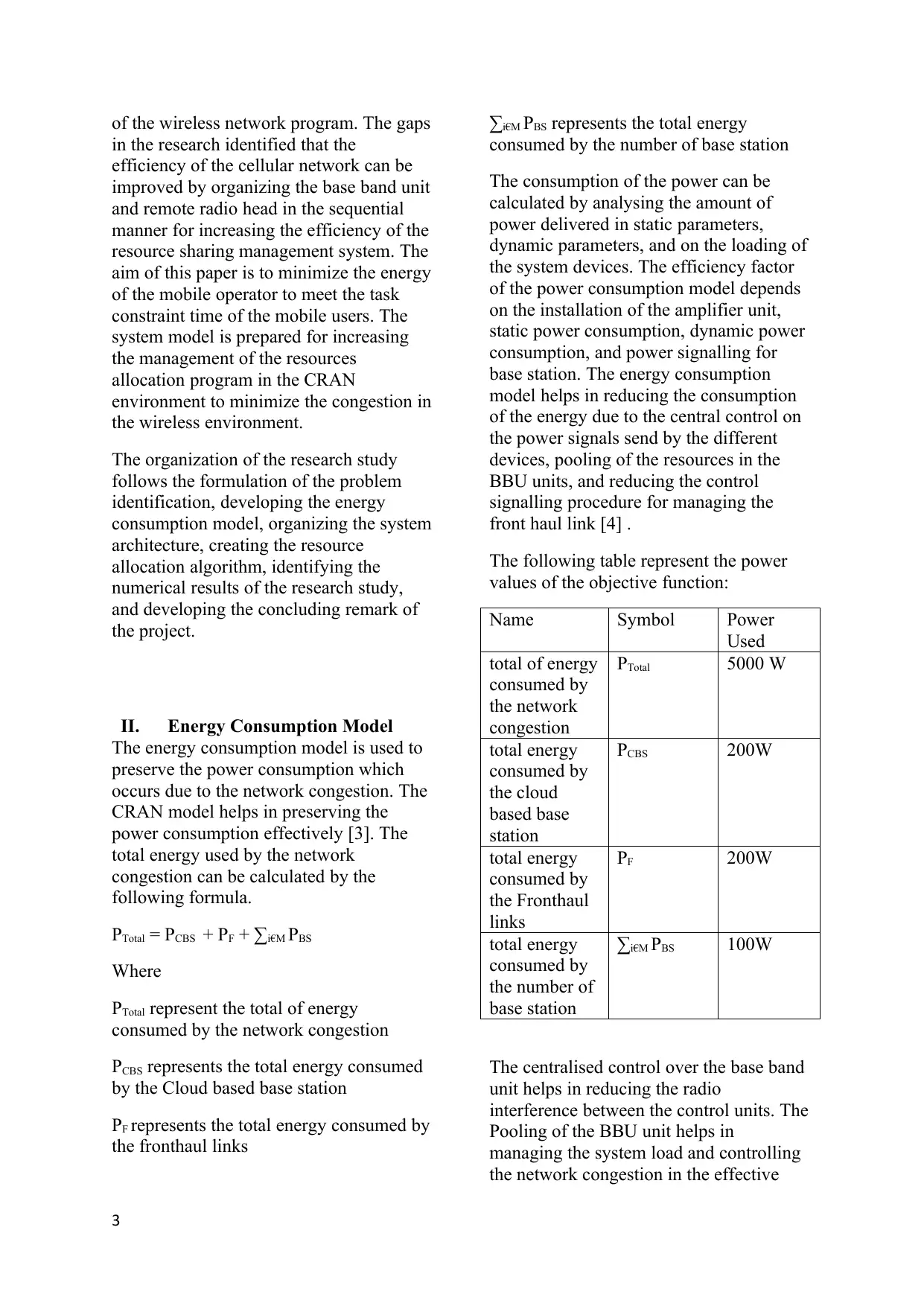
of the wireless network program. The gaps
in the research identified that the
efficiency of the cellular network can be
improved by organizing the base band unit
and remote radio head in the sequential
manner for increasing the efficiency of the
resource sharing management system. The
aim of this paper is to minimize the energy
of the mobile operator to meet the task
constraint time of the mobile users. The
system model is prepared for increasing
the management of the resources
allocation program in the CRAN
environment to minimize the congestion in
the wireless environment.
The organization of the research study
follows the formulation of the problem
identification, developing the energy
consumption model, organizing the system
architecture, creating the resource
allocation algorithm, identifying the
numerical results of the research study,
and developing the concluding remark of
the project.
II. Energy Consumption Model
The energy consumption model is used to
preserve the power consumption which
occurs due to the network congestion. The
CRAN model helps in preserving the
power consumption effectively [3]. The
total energy used by the network
congestion can be calculated by the
following formula.
PTotal = PCBS + PF + ∑i€M PBS
Where
PTotal represent the total of energy
consumed by the network congestion
PCBS represents the total energy consumed
by the Cloud based base station
PF represents the total energy consumed by
the fronthaul links
∑i€M PBS represents the total energy
consumed by the number of base station
The consumption of the power can be
calculated by analysing the amount of
power delivered in static parameters,
dynamic parameters, and on the loading of
the system devices. The efficiency factor
of the power consumption model depends
on the installation of the amplifier unit,
static power consumption, dynamic power
consumption, and power signalling for
base station. The energy consumption
model helps in reducing the consumption
of the energy due to the central control on
the power signals send by the different
devices, pooling of the resources in the
BBU units, and reducing the control
signalling procedure for managing the
front haul link [4] .
The following table represent the power
values of the objective function:
Name Symbol Power
Used
total of energy
consumed by
the network
congestion
PTotal 5000 W
total energy
consumed by
the cloud
based base
station
PCBS 200W
total energy
consumed by
the Fronthaul
links
PF 200W
total energy
consumed by
the number of
base station
∑i€M PBS 100W
The centralised control over the base band
unit helps in reducing the radio
interference between the control units. The
Pooling of the BBU unit helps in
managing the system load and controlling
the network congestion in the effective
3
in the research identified that the
efficiency of the cellular network can be
improved by organizing the base band unit
and remote radio head in the sequential
manner for increasing the efficiency of the
resource sharing management system. The
aim of this paper is to minimize the energy
of the mobile operator to meet the task
constraint time of the mobile users. The
system model is prepared for increasing
the management of the resources
allocation program in the CRAN
environment to minimize the congestion in
the wireless environment.
The organization of the research study
follows the formulation of the problem
identification, developing the energy
consumption model, organizing the system
architecture, creating the resource
allocation algorithm, identifying the
numerical results of the research study,
and developing the concluding remark of
the project.
II. Energy Consumption Model
The energy consumption model is used to
preserve the power consumption which
occurs due to the network congestion. The
CRAN model helps in preserving the
power consumption effectively [3]. The
total energy used by the network
congestion can be calculated by the
following formula.
PTotal = PCBS + PF + ∑i€M PBS
Where
PTotal represent the total of energy
consumed by the network congestion
PCBS represents the total energy consumed
by the Cloud based base station
PF represents the total energy consumed by
the fronthaul links
∑i€M PBS represents the total energy
consumed by the number of base station
The consumption of the power can be
calculated by analysing the amount of
power delivered in static parameters,
dynamic parameters, and on the loading of
the system devices. The efficiency factor
of the power consumption model depends
on the installation of the amplifier unit,
static power consumption, dynamic power
consumption, and power signalling for
base station. The energy consumption
model helps in reducing the consumption
of the energy due to the central control on
the power signals send by the different
devices, pooling of the resources in the
BBU units, and reducing the control
signalling procedure for managing the
front haul link [4] .
The following table represent the power
values of the objective function:
Name Symbol Power
Used
total of energy
consumed by
the network
congestion
PTotal 5000 W
total energy
consumed by
the cloud
based base
station
PCBS 200W
total energy
consumed by
the Fronthaul
links
PF 200W
total energy
consumed by
the number of
base station
∑i€M PBS 100W
The centralised control over the base band
unit helps in reducing the radio
interference between the control units. The
Pooling of the BBU unit helps in
managing the system load and controlling
the network congestion in the effective
3
Paraphrase This Document
Need a fresh take? Get an instant paraphrase of this document with our AI Paraphraser
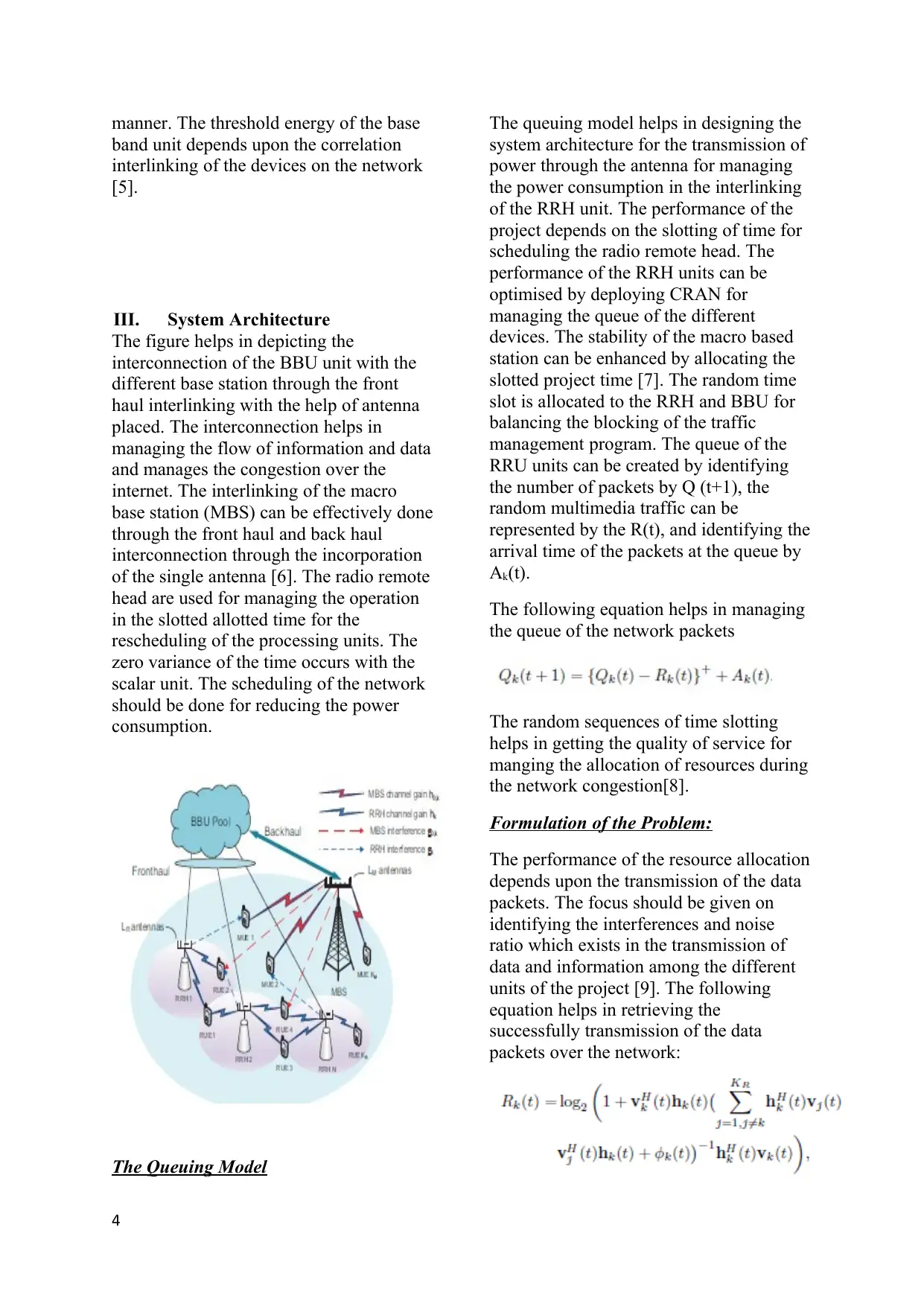
manner. The threshold energy of the base
band unit depends upon the correlation
interlinking of the devices on the network
[5].
III. System Architecture
The figure helps in depicting the
interconnection of the BBU unit with the
different base station through the front
haul interlinking with the help of antenna
placed. The interconnection helps in
managing the flow of information and data
and manages the congestion over the
internet. The interlinking of the macro
base station (MBS) can be effectively done
through the front haul and back haul
interconnection through the incorporation
of the single antenna [6]. The radio remote
head are used for managing the operation
in the slotted allotted time for the
rescheduling of the processing units. The
zero variance of the time occurs with the
scalar unit. The scheduling of the network
should be done for reducing the power
consumption.
The Queuing Model
The queuing model helps in designing the
system architecture for the transmission of
power through the antenna for managing
the power consumption in the interlinking
of the RRH unit. The performance of the
project depends on the slotting of time for
scheduling the radio remote head. The
performance of the RRH units can be
optimised by deploying CRAN for
managing the queue of the different
devices. The stability of the macro based
station can be enhanced by allocating the
slotted project time [7]. The random time
slot is allocated to the RRH and BBU for
balancing the blocking of the traffic
management program. The queue of the
RRU units can be created by identifying
the number of packets by Q (t+1), the
random multimedia traffic can be
represented by the R(t), and identifying the
arrival time of the packets at the queue by
Ak(t).
The following equation helps in managing
the queue of the network packets
The random sequences of time slotting
helps in getting the quality of service for
manging the allocation of resources during
the network congestion[8].
Formulation of the Problem:
The performance of the resource allocation
depends upon the transmission of the data
packets. The focus should be given on
identifying the interferences and noise
ratio which exists in the transmission of
data and information among the different
units of the project [9]. The following
equation helps in retrieving the
successfully transmission of the data
packets over the network:
4
band unit depends upon the correlation
interlinking of the devices on the network
[5].
III. System Architecture
The figure helps in depicting the
interconnection of the BBU unit with the
different base station through the front
haul interlinking with the help of antenna
placed. The interconnection helps in
managing the flow of information and data
and manages the congestion over the
internet. The interlinking of the macro
base station (MBS) can be effectively done
through the front haul and back haul
interconnection through the incorporation
of the single antenna [6]. The radio remote
head are used for managing the operation
in the slotted allotted time for the
rescheduling of the processing units. The
zero variance of the time occurs with the
scalar unit. The scheduling of the network
should be done for reducing the power
consumption.
The Queuing Model
The queuing model helps in designing the
system architecture for the transmission of
power through the antenna for managing
the power consumption in the interlinking
of the RRH unit. The performance of the
project depends on the slotting of time for
scheduling the radio remote head. The
performance of the RRH units can be
optimised by deploying CRAN for
managing the queue of the different
devices. The stability of the macro based
station can be enhanced by allocating the
slotted project time [7]. The random time
slot is allocated to the RRH and BBU for
balancing the blocking of the traffic
management program. The queue of the
RRU units can be created by identifying
the number of packets by Q (t+1), the
random multimedia traffic can be
represented by the R(t), and identifying the
arrival time of the packets at the queue by
Ak(t).
The following equation helps in managing
the queue of the network packets
The random sequences of time slotting
helps in getting the quality of service for
manging the allocation of resources during
the network congestion[8].
Formulation of the Problem:
The performance of the resource allocation
depends upon the transmission of the data
packets. The focus should be given on
identifying the interferences and noise
ratio which exists in the transmission of
data and information among the different
units of the project [9]. The following
equation helps in retrieving the
successfully transmission of the data
packets over the network:
4
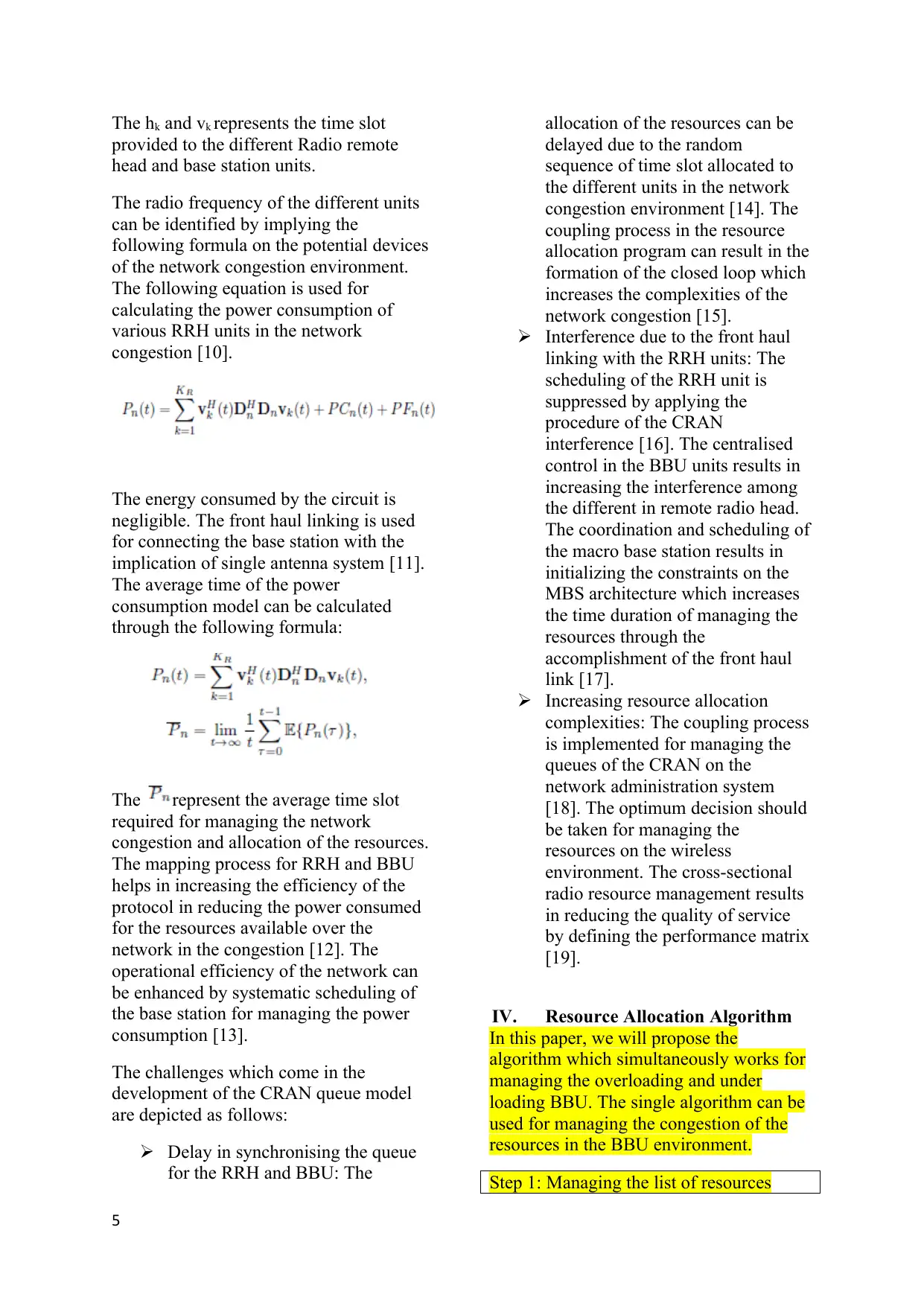
The hk and vk represents the time slot
provided to the different Radio remote
head and base station units.
The radio frequency of the different units
can be identified by implying the
following formula on the potential devices
of the network congestion environment.
The following equation is used for
calculating the power consumption of
various RRH units in the network
congestion [10].
The energy consumed by the circuit is
negligible. The front haul linking is used
for connecting the base station with the
implication of single antenna system [11].
The average time of the power
consumption model can be calculated
through the following formula:
The represent the average time slot
required for managing the network
congestion and allocation of the resources.
The mapping process for RRH and BBU
helps in increasing the efficiency of the
protocol in reducing the power consumed
for the resources available over the
network in the congestion [12]. The
operational efficiency of the network can
be enhanced by systematic scheduling of
the base station for managing the power
consumption [13].
The challenges which come in the
development of the CRAN queue model
are depicted as follows:
Delay in synchronising the queue
for the RRH and BBU: The
allocation of the resources can be
delayed due to the random
sequence of time slot allocated to
the different units in the network
congestion environment [14]. The
coupling process in the resource
allocation program can result in the
formation of the closed loop which
increases the complexities of the
network congestion [15].
Interference due to the front haul
linking with the RRH units: The
scheduling of the RRH unit is
suppressed by applying the
procedure of the CRAN
interference [16]. The centralised
control in the BBU units results in
increasing the interference among
the different in remote radio head.
The coordination and scheduling of
the macro base station results in
initializing the constraints on the
MBS architecture which increases
the time duration of managing the
resources through the
accomplishment of the front haul
link [17].
Increasing resource allocation
complexities: The coupling process
is implemented for managing the
queues of the CRAN on the
network administration system
[18]. The optimum decision should
be taken for managing the
resources on the wireless
environment. The cross-sectional
radio resource management results
in reducing the quality of service
by defining the performance matrix
[19].
IV. Resource Allocation Algorithm
In this paper, we will propose the
algorithm which simultaneously works for
managing the overloading and under
loading BBU. The single algorithm can be
used for managing the congestion of the
resources in the BBU environment.
Step 1: Managing the list of resources
5
provided to the different Radio remote
head and base station units.
The radio frequency of the different units
can be identified by implying the
following formula on the potential devices
of the network congestion environment.
The following equation is used for
calculating the power consumption of
various RRH units in the network
congestion [10].
The energy consumed by the circuit is
negligible. The front haul linking is used
for connecting the base station with the
implication of single antenna system [11].
The average time of the power
consumption model can be calculated
through the following formula:
The represent the average time slot
required for managing the network
congestion and allocation of the resources.
The mapping process for RRH and BBU
helps in increasing the efficiency of the
protocol in reducing the power consumed
for the resources available over the
network in the congestion [12]. The
operational efficiency of the network can
be enhanced by systematic scheduling of
the base station for managing the power
consumption [13].
The challenges which come in the
development of the CRAN queue model
are depicted as follows:
Delay in synchronising the queue
for the RRH and BBU: The
allocation of the resources can be
delayed due to the random
sequence of time slot allocated to
the different units in the network
congestion environment [14]. The
coupling process in the resource
allocation program can result in the
formation of the closed loop which
increases the complexities of the
network congestion [15].
Interference due to the front haul
linking with the RRH units: The
scheduling of the RRH unit is
suppressed by applying the
procedure of the CRAN
interference [16]. The centralised
control in the BBU units results in
increasing the interference among
the different in remote radio head.
The coordination and scheduling of
the macro base station results in
initializing the constraints on the
MBS architecture which increases
the time duration of managing the
resources through the
accomplishment of the front haul
link [17].
Increasing resource allocation
complexities: The coupling process
is implemented for managing the
queues of the CRAN on the
network administration system
[18]. The optimum decision should
be taken for managing the
resources on the wireless
environment. The cross-sectional
radio resource management results
in reducing the quality of service
by defining the performance matrix
[19].
IV. Resource Allocation Algorithm
In this paper, we will propose the
algorithm which simultaneously works for
managing the overloading and under
loading BBU. The single algorithm can be
used for managing the congestion of the
resources in the BBU environment.
Step 1: Managing the list of resources
5
⊘ This is a preview!⊘
Do you want full access?
Subscribe today to unlock all pages.

Trusted by 1+ million students worldwide
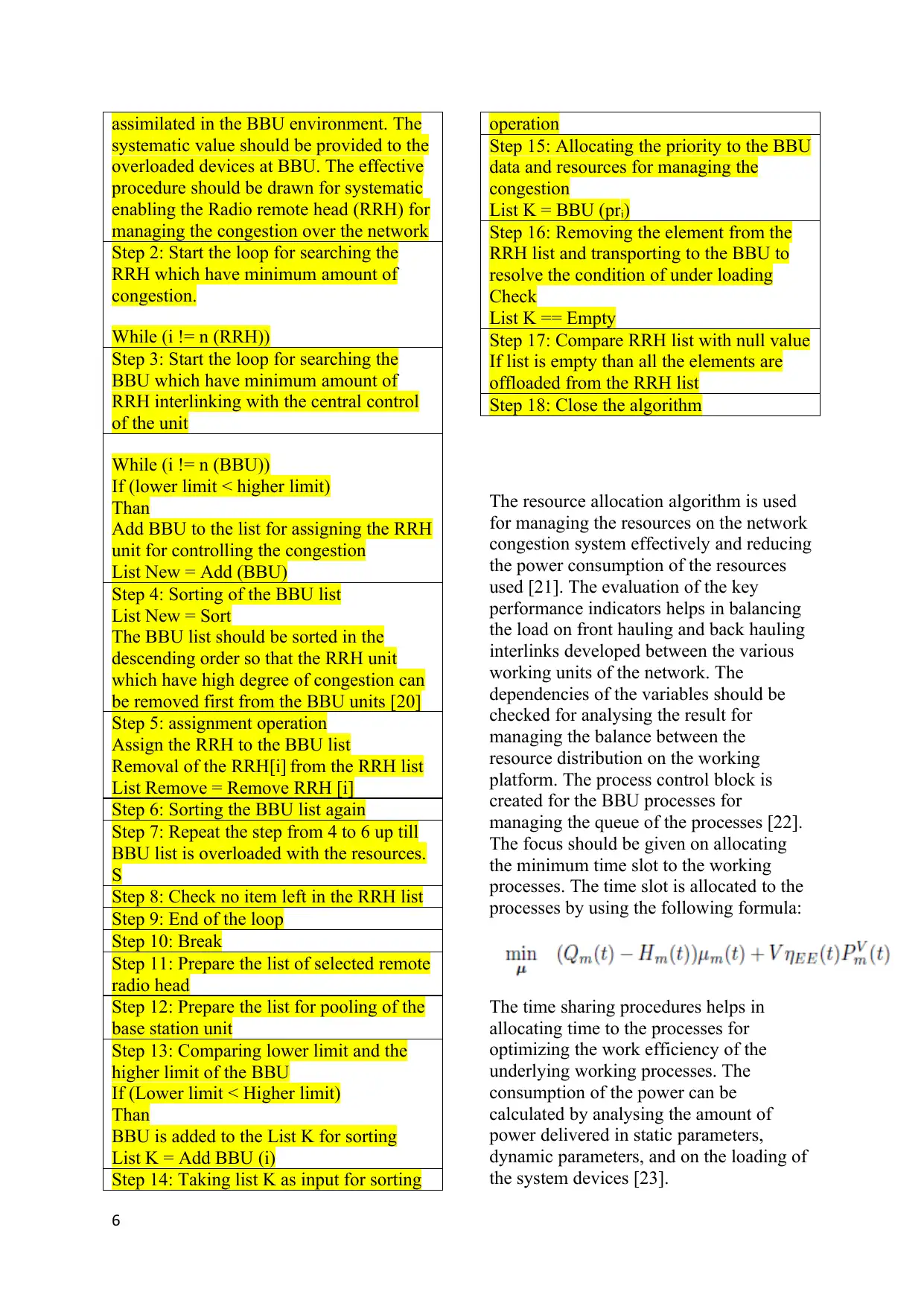
assimilated in the BBU environment. The
systematic value should be provided to the
overloaded devices at BBU. The effective
procedure should be drawn for systematic
enabling the Radio remote head (RRH) for
managing the congestion over the network
Step 2: Start the loop for searching the
RRH which have minimum amount of
congestion.
While (i != n (RRH))
Step 3: Start the loop for searching the
BBU which have minimum amount of
RRH interlinking with the central control
of the unit
While (i != n (BBU))
If (lower limit < higher limit)
Than
Add BBU to the list for assigning the RRH
unit for controlling the congestion
List New = Add (BBU)
Step 4: Sorting of the BBU list
List New = Sort
The BBU list should be sorted in the
descending order so that the RRH unit
which have high degree of congestion can
be removed first from the BBU units [20]
Step 5: assignment operation
Assign the RRH to the BBU list
Removal of the RRH[i] from the RRH list
List Remove = Remove RRH [i]
Step 6: Sorting the BBU list again
Step 7: Repeat the step from 4 to 6 up till
BBU list is overloaded with the resources.
S
Step 8: Check no item left in the RRH list
Step 9: End of the loop
Step 10: Break
Step 11: Prepare the list of selected remote
radio head
Step 12: Prepare the list for pooling of the
base station unit
Step 13: Comparing lower limit and the
higher limit of the BBU
If (Lower limit < Higher limit)
Than
BBU is added to the List K for sorting
List K = Add BBU (i)
Step 14: Taking list K as input for sorting
operation
Step 15: Allocating the priority to the BBU
data and resources for managing the
congestion
List K = BBU (pri)
Step 16: Removing the element from the
RRH list and transporting to the BBU to
resolve the condition of under loading
Check
List K == Empty
Step 17: Compare RRH list with null value
If list is empty than all the elements are
offloaded from the RRH list
Step 18: Close the algorithm
The resource allocation algorithm is used
for managing the resources on the network
congestion system effectively and reducing
the power consumption of the resources
used [21]. The evaluation of the key
performance indicators helps in balancing
the load on front hauling and back hauling
interlinks developed between the various
working units of the network. The
dependencies of the variables should be
checked for analysing the result for
managing the balance between the
resource distribution on the working
platform. The process control block is
created for the BBU processes for
managing the queue of the processes [22].
The focus should be given on allocating
the minimum time slot to the working
processes. The time slot is allocated to the
processes by using the following formula:
The time sharing procedures helps in
allocating time to the processes for
optimizing the work efficiency of the
underlying working processes. The
consumption of the power can be
calculated by analysing the amount of
power delivered in static parameters,
dynamic parameters, and on the loading of
the system devices [23].
6
systematic value should be provided to the
overloaded devices at BBU. The effective
procedure should be drawn for systematic
enabling the Radio remote head (RRH) for
managing the congestion over the network
Step 2: Start the loop for searching the
RRH which have minimum amount of
congestion.
While (i != n (RRH))
Step 3: Start the loop for searching the
BBU which have minimum amount of
RRH interlinking with the central control
of the unit
While (i != n (BBU))
If (lower limit < higher limit)
Than
Add BBU to the list for assigning the RRH
unit for controlling the congestion
List New = Add (BBU)
Step 4: Sorting of the BBU list
List New = Sort
The BBU list should be sorted in the
descending order so that the RRH unit
which have high degree of congestion can
be removed first from the BBU units [20]
Step 5: assignment operation
Assign the RRH to the BBU list
Removal of the RRH[i] from the RRH list
List Remove = Remove RRH [i]
Step 6: Sorting the BBU list again
Step 7: Repeat the step from 4 to 6 up till
BBU list is overloaded with the resources.
S
Step 8: Check no item left in the RRH list
Step 9: End of the loop
Step 10: Break
Step 11: Prepare the list of selected remote
radio head
Step 12: Prepare the list for pooling of the
base station unit
Step 13: Comparing lower limit and the
higher limit of the BBU
If (Lower limit < Higher limit)
Than
BBU is added to the List K for sorting
List K = Add BBU (i)
Step 14: Taking list K as input for sorting
operation
Step 15: Allocating the priority to the BBU
data and resources for managing the
congestion
List K = BBU (pri)
Step 16: Removing the element from the
RRH list and transporting to the BBU to
resolve the condition of under loading
Check
List K == Empty
Step 17: Compare RRH list with null value
If list is empty than all the elements are
offloaded from the RRH list
Step 18: Close the algorithm
The resource allocation algorithm is used
for managing the resources on the network
congestion system effectively and reducing
the power consumption of the resources
used [21]. The evaluation of the key
performance indicators helps in balancing
the load on front hauling and back hauling
interlinks developed between the various
working units of the network. The
dependencies of the variables should be
checked for analysing the result for
managing the balance between the
resource distribution on the working
platform. The process control block is
created for the BBU processes for
managing the queue of the processes [22].
The focus should be given on allocating
the minimum time slot to the working
processes. The time slot is allocated to the
processes by using the following formula:
The time sharing procedures helps in
allocating time to the processes for
optimizing the work efficiency of the
underlying working processes. The
consumption of the power can be
calculated by analysing the amount of
power delivered in static parameters,
dynamic parameters, and on the loading of
the system devices [23].
6
Paraphrase This Document
Need a fresh take? Get an instant paraphrase of this document with our AI Paraphraser
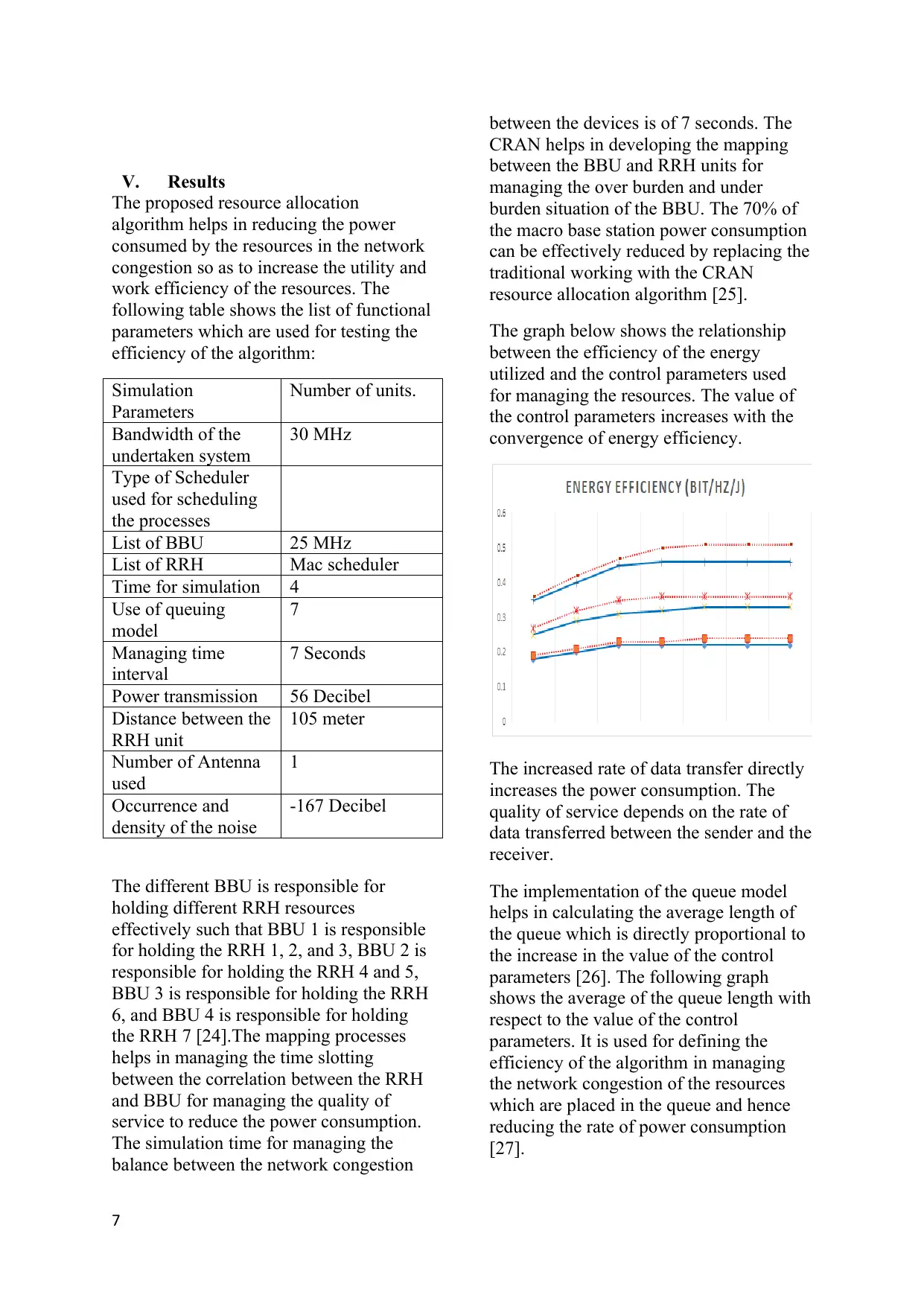
V. Results
The proposed resource allocation
algorithm helps in reducing the power
consumed by the resources in the network
congestion so as to increase the utility and
work efficiency of the resources. The
following table shows the list of functional
parameters which are used for testing the
efficiency of the algorithm:
Simulation
Parameters
Number of units.
Bandwidth of the
undertaken system
30 MHz
Type of Scheduler
used for scheduling
the processes
List of BBU 25 MHz
List of RRH Mac scheduler
Time for simulation 4
Use of queuing
model
7
Managing time
interval
7 Seconds
Power transmission 56 Decibel
Distance between the
RRH unit
105 meter
Number of Antenna
used
1
Occurrence and
density of the noise
-167 Decibel
The different BBU is responsible for
holding different RRH resources
effectively such that BBU 1 is responsible
for holding the RRH 1, 2, and 3, BBU 2 is
responsible for holding the RRH 4 and 5,
BBU 3 is responsible for holding the RRH
6, and BBU 4 is responsible for holding
the RRH 7 [24].The mapping processes
helps in managing the time slotting
between the correlation between the RRH
and BBU for managing the quality of
service to reduce the power consumption.
The simulation time for managing the
balance between the network congestion
between the devices is of 7 seconds. The
CRAN helps in developing the mapping
between the BBU and RRH units for
managing the over burden and under
burden situation of the BBU. The 70% of
the macro base station power consumption
can be effectively reduced by replacing the
traditional working with the CRAN
resource allocation algorithm [25].
The graph below shows the relationship
between the efficiency of the energy
utilized and the control parameters used
for managing the resources. The value of
the control parameters increases with the
convergence of energy efficiency.
The increased rate of data transfer directly
increases the power consumption. The
quality of service depends on the rate of
data transferred between the sender and the
receiver.
The implementation of the queue model
helps in calculating the average length of
the queue which is directly proportional to
the increase in the value of the control
parameters [26]. The following graph
shows the average of the queue length with
respect to the value of the control
parameters. It is used for defining the
efficiency of the algorithm in managing
the network congestion of the resources
which are placed in the queue and hence
reducing the rate of power consumption
[27].
7
The proposed resource allocation
algorithm helps in reducing the power
consumed by the resources in the network
congestion so as to increase the utility and
work efficiency of the resources. The
following table shows the list of functional
parameters which are used for testing the
efficiency of the algorithm:
Simulation
Parameters
Number of units.
Bandwidth of the
undertaken system
30 MHz
Type of Scheduler
used for scheduling
the processes
List of BBU 25 MHz
List of RRH Mac scheduler
Time for simulation 4
Use of queuing
model
7
Managing time
interval
7 Seconds
Power transmission 56 Decibel
Distance between the
RRH unit
105 meter
Number of Antenna
used
1
Occurrence and
density of the noise
-167 Decibel
The different BBU is responsible for
holding different RRH resources
effectively such that BBU 1 is responsible
for holding the RRH 1, 2, and 3, BBU 2 is
responsible for holding the RRH 4 and 5,
BBU 3 is responsible for holding the RRH
6, and BBU 4 is responsible for holding
the RRH 7 [24].The mapping processes
helps in managing the time slotting
between the correlation between the RRH
and BBU for managing the quality of
service to reduce the power consumption.
The simulation time for managing the
balance between the network congestion
between the devices is of 7 seconds. The
CRAN helps in developing the mapping
between the BBU and RRH units for
managing the over burden and under
burden situation of the BBU. The 70% of
the macro base station power consumption
can be effectively reduced by replacing the
traditional working with the CRAN
resource allocation algorithm [25].
The graph below shows the relationship
between the efficiency of the energy
utilized and the control parameters used
for managing the resources. The value of
the control parameters increases with the
convergence of energy efficiency.
The increased rate of data transfer directly
increases the power consumption. The
quality of service depends on the rate of
data transferred between the sender and the
receiver.
The implementation of the queue model
helps in calculating the average length of
the queue which is directly proportional to
the increase in the value of the control
parameters [26]. The following graph
shows the average of the queue length with
respect to the value of the control
parameters. It is used for defining the
efficiency of the algorithm in managing
the network congestion of the resources
which are placed in the queue and hence
reducing the rate of power consumption
[27].
7
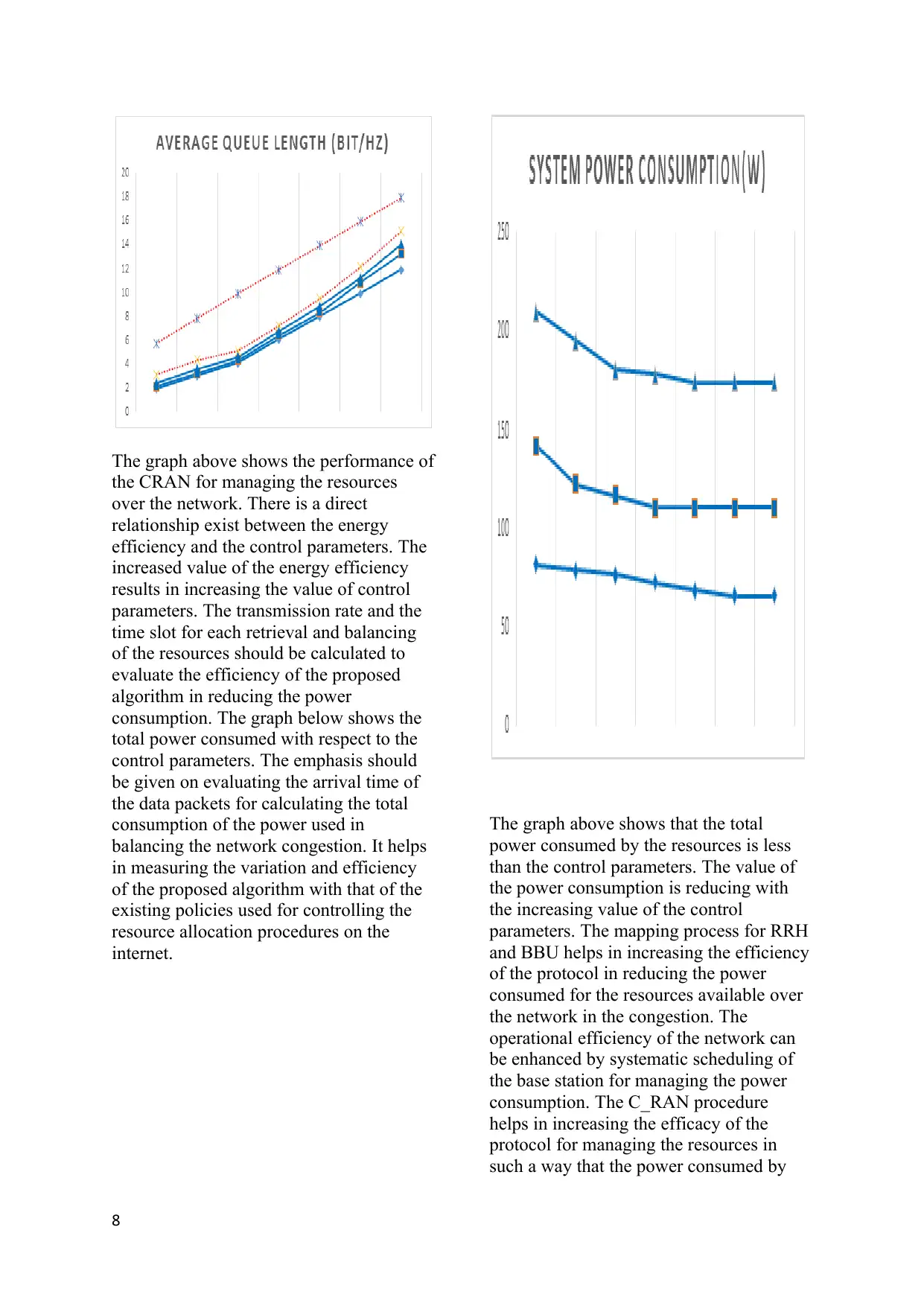
The graph above shows the performance of
the CRAN for managing the resources
over the network. There is a direct
relationship exist between the energy
efficiency and the control parameters. The
increased value of the energy efficiency
results in increasing the value of control
parameters. The transmission rate and the
time slot for each retrieval and balancing
of the resources should be calculated to
evaluate the efficiency of the proposed
algorithm in reducing the power
consumption. The graph below shows the
total power consumed with respect to the
control parameters. The emphasis should
be given on evaluating the arrival time of
the data packets for calculating the total
consumption of the power used in
balancing the network congestion. It helps
in measuring the variation and efficiency
of the proposed algorithm with that of the
existing policies used for controlling the
resource allocation procedures on the
internet.
The graph above shows that the total
power consumed by the resources is less
than the control parameters. The value of
the power consumption is reducing with
the increasing value of the control
parameters. The mapping process for RRH
and BBU helps in increasing the efficiency
of the protocol in reducing the power
consumed for the resources available over
the network in the congestion. The
operational efficiency of the network can
be enhanced by systematic scheduling of
the base station for managing the power
consumption. The C_RAN procedure
helps in increasing the efficacy of the
protocol for managing the resources in
such a way that the power consumed by
8
the CRAN for managing the resources
over the network. There is a direct
relationship exist between the energy
efficiency and the control parameters. The
increased value of the energy efficiency
results in increasing the value of control
parameters. The transmission rate and the
time slot for each retrieval and balancing
of the resources should be calculated to
evaluate the efficiency of the proposed
algorithm in reducing the power
consumption. The graph below shows the
total power consumed with respect to the
control parameters. The emphasis should
be given on evaluating the arrival time of
the data packets for calculating the total
consumption of the power used in
balancing the network congestion. It helps
in measuring the variation and efficiency
of the proposed algorithm with that of the
existing policies used for controlling the
resource allocation procedures on the
internet.
The graph above shows that the total
power consumed by the resources is less
than the control parameters. The value of
the power consumption is reducing with
the increasing value of the control
parameters. The mapping process for RRH
and BBU helps in increasing the efficiency
of the protocol in reducing the power
consumed for the resources available over
the network in the congestion. The
operational efficiency of the network can
be enhanced by systematic scheduling of
the base station for managing the power
consumption. The C_RAN procedure
helps in increasing the efficacy of the
protocol for managing the resources in
such a way that the power consumed by
8
⊘ This is a preview!⊘
Do you want full access?
Subscribe today to unlock all pages.

Trusted by 1+ million students worldwide
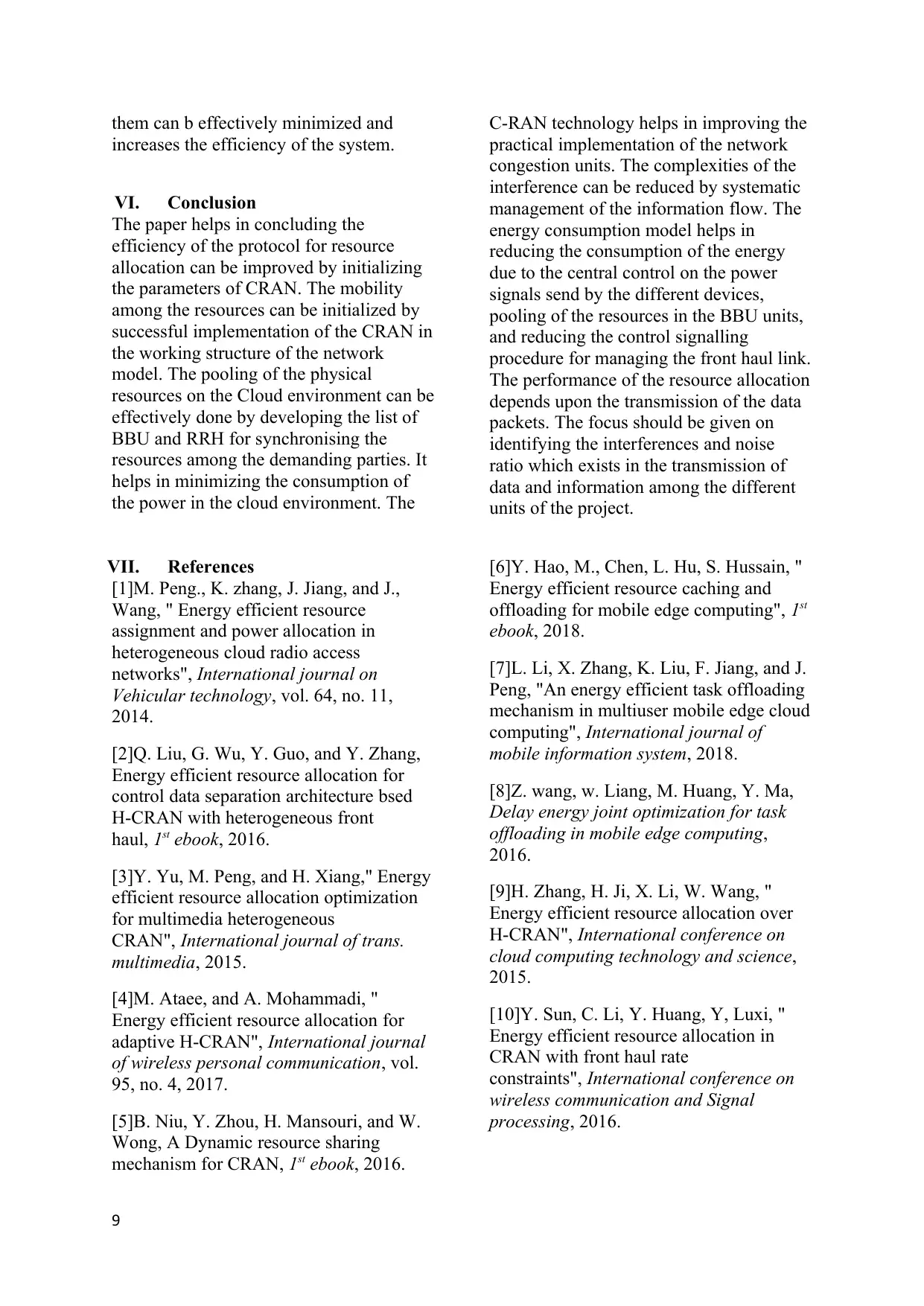
them can b effectively minimized and
increases the efficiency of the system.
VI. Conclusion
The paper helps in concluding the
efficiency of the protocol for resource
allocation can be improved by initializing
the parameters of CRAN. The mobility
among the resources can be initialized by
successful implementation of the CRAN in
the working structure of the network
model. The pooling of the physical
resources on the Cloud environment can be
effectively done by developing the list of
BBU and RRH for synchronising the
resources among the demanding parties. It
helps in minimizing the consumption of
the power in the cloud environment. The
C-RAN technology helps in improving the
practical implementation of the network
congestion units. The complexities of the
interference can be reduced by systematic
management of the information flow. The
energy consumption model helps in
reducing the consumption of the energy
due to the central control on the power
signals send by the different devices,
pooling of the resources in the BBU units,
and reducing the control signalling
procedure for managing the front haul link.
The performance of the resource allocation
depends upon the transmission of the data
packets. The focus should be given on
identifying the interferences and noise
ratio which exists in the transmission of
data and information among the different
units of the project.
VII. References
[1]M. Peng., K. zhang, J. Jiang, and J.,
Wang, " Energy efficient resource
assignment and power allocation in
heterogeneous cloud radio access
networks", International journal on
Vehicular technology, vol. 64, no. 11,
2014.
[2]Q. Liu, G. Wu, Y. Guo, and Y. Zhang,
Energy efficient resource allocation for
control data separation architecture bsed
H-CRAN with heterogeneous front
haul, 1st ebook, 2016.
[3]Y. Yu, M. Peng, and H. Xiang," Energy
efficient resource allocation optimization
for multimedia heterogeneous
CRAN", International journal of trans.
multimedia, 2015.
[4]M. Ataee, and A. Mohammadi, "
Energy efficient resource allocation for
adaptive H-CRAN", International journal
of wireless personal communication, vol.
95, no. 4, 2017.
[5]B. Niu, Y. Zhou, H. Mansouri, and W.
Wong, A Dynamic resource sharing
mechanism for CRAN, 1st ebook, 2016.
[6]Y. Hao, M., Chen, L. Hu, S. Hussain, "
Energy efficient resource caching and
offloading for mobile edge computing", 1st
ebook, 2018.
[7]L. Li, X. Zhang, K. Liu, F. Jiang, and J.
Peng, "An energy efficient task offloading
mechanism in multiuser mobile edge cloud
computing", International journal of
mobile information system, 2018.
[8]Z. wang, w. Liang, M. Huang, Y. Ma,
Delay energy joint optimization for task
offloading in mobile edge computing,
2016.
[9]H. Zhang, H. Ji, X. Li, W. Wang, "
Energy efficient resource allocation over
H-CRAN", International conference on
cloud computing technology and science,
2015.
[10]Y. Sun, C. Li, Y. Huang, Y, Luxi, "
Energy efficient resource allocation in
CRAN with front haul rate
constraints", International conference on
wireless communication and Signal
processing, 2016.
9
increases the efficiency of the system.
VI. Conclusion
The paper helps in concluding the
efficiency of the protocol for resource
allocation can be improved by initializing
the parameters of CRAN. The mobility
among the resources can be initialized by
successful implementation of the CRAN in
the working structure of the network
model. The pooling of the physical
resources on the Cloud environment can be
effectively done by developing the list of
BBU and RRH for synchronising the
resources among the demanding parties. It
helps in minimizing the consumption of
the power in the cloud environment. The
C-RAN technology helps in improving the
practical implementation of the network
congestion units. The complexities of the
interference can be reduced by systematic
management of the information flow. The
energy consumption model helps in
reducing the consumption of the energy
due to the central control on the power
signals send by the different devices,
pooling of the resources in the BBU units,
and reducing the control signalling
procedure for managing the front haul link.
The performance of the resource allocation
depends upon the transmission of the data
packets. The focus should be given on
identifying the interferences and noise
ratio which exists in the transmission of
data and information among the different
units of the project.
VII. References
[1]M. Peng., K. zhang, J. Jiang, and J.,
Wang, " Energy efficient resource
assignment and power allocation in
heterogeneous cloud radio access
networks", International journal on
Vehicular technology, vol. 64, no. 11,
2014.
[2]Q. Liu, G. Wu, Y. Guo, and Y. Zhang,
Energy efficient resource allocation for
control data separation architecture bsed
H-CRAN with heterogeneous front
haul, 1st ebook, 2016.
[3]Y. Yu, M. Peng, and H. Xiang," Energy
efficient resource allocation optimization
for multimedia heterogeneous
CRAN", International journal of trans.
multimedia, 2015.
[4]M. Ataee, and A. Mohammadi, "
Energy efficient resource allocation for
adaptive H-CRAN", International journal
of wireless personal communication, vol.
95, no. 4, 2017.
[5]B. Niu, Y. Zhou, H. Mansouri, and W.
Wong, A Dynamic resource sharing
mechanism for CRAN, 1st ebook, 2016.
[6]Y. Hao, M., Chen, L. Hu, S. Hussain, "
Energy efficient resource caching and
offloading for mobile edge computing", 1st
ebook, 2018.
[7]L. Li, X. Zhang, K. Liu, F. Jiang, and J.
Peng, "An energy efficient task offloading
mechanism in multiuser mobile edge cloud
computing", International journal of
mobile information system, 2018.
[8]Z. wang, w. Liang, M. Huang, Y. Ma,
Delay energy joint optimization for task
offloading in mobile edge computing,
2016.
[9]H. Zhang, H. Ji, X. Li, W. Wang, "
Energy efficient resource allocation over
H-CRAN", International conference on
cloud computing technology and science,
2015.
[10]Y. Sun, C. Li, Y. Huang, Y, Luxi, "
Energy efficient resource allocation in
CRAN with front haul rate
constraints", International conference on
wireless communication and Signal
processing, 2016.
9
Paraphrase This Document
Need a fresh take? Get an instant paraphrase of this document with our AI Paraphraser
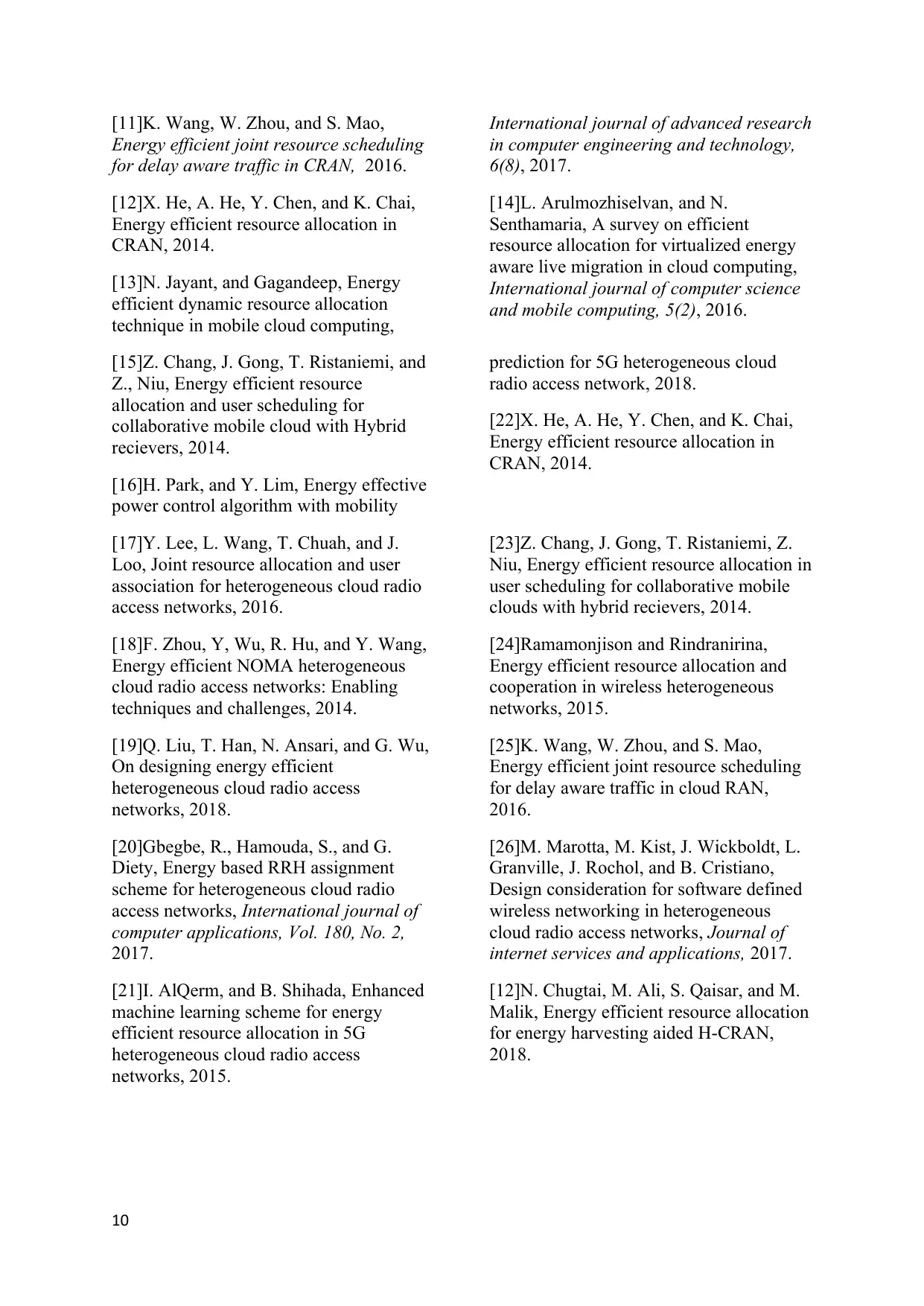
[11]K. Wang, W. Zhou, and S. Mao,
Energy efficient joint resource scheduling
for delay aware traffic in CRAN, 2016.
[12]X. He, A. He, Y. Chen, and K. Chai,
Energy efficient resource allocation in
CRAN, 2014.
[13]N. Jayant, and Gagandeep, Energy
efficient dynamic resource allocation
technique in mobile cloud computing,
International journal of advanced research
in computer engineering and technology,
6(8), 2017.
[14]L. Arulmozhiselvan, and N.
Senthamaria, A survey on efficient
resource allocation for virtualized energy
aware live migration in cloud computing,
International journal of computer science
and mobile computing, 5(2), 2016.
[15]Z. Chang, J. Gong, T. Ristaniemi, and
Z., Niu, Energy efficient resource
allocation and user scheduling for
collaborative mobile cloud with Hybrid
recievers, 2014.
[16]H. Park, and Y. Lim, Energy effective
power control algorithm with mobility
prediction for 5G heterogeneous cloud
radio access network, 2018.
[22]X. He, A. He, Y. Chen, and K. Chai,
Energy efficient resource allocation in
CRAN, 2014.
[17]Y. Lee, L. Wang, T. Chuah, and J.
Loo, Joint resource allocation and user
association for heterogeneous cloud radio
access networks, 2016.
[18]F. Zhou, Y, Wu, R. Hu, and Y. Wang,
Energy efficient NOMA heterogeneous
cloud radio access networks: Enabling
techniques and challenges, 2014.
[19]Q. Liu, T. Han, N. Ansari, and G. Wu,
On designing energy efficient
heterogeneous cloud radio access
networks, 2018.
[20]Gbegbe, R., Hamouda, S., and G.
Diety, Energy based RRH assignment
scheme for heterogeneous cloud radio
access networks, International journal of
computer applications, Vol. 180, No. 2,
2017.
[21]I. AlQerm, and B. Shihada, Enhanced
machine learning scheme for energy
efficient resource allocation in 5G
heterogeneous cloud radio access
networks, 2015.
[23]Z. Chang, J. Gong, T. Ristaniemi, Z.
Niu, Energy efficient resource allocation in
user scheduling for collaborative mobile
clouds with hybrid recievers, 2014.
[24]Ramamonjison and Rindranirina,
Energy efficient resource allocation and
cooperation in wireless heterogeneous
networks, 2015.
[25]K. Wang, W. Zhou, and S. Mao,
Energy efficient joint resource scheduling
for delay aware traffic in cloud RAN,
2016.
[26]M. Marotta, M. Kist, J. Wickboldt, L.
Granville, J. Rochol, and B. Cristiano,
Design consideration for software defined
wireless networking in heterogeneous
cloud radio access networks, Journal of
internet services and applications, 2017.
[12]N. Chugtai, M. Ali, S. Qaisar, and M.
Malik, Energy efficient resource allocation
for energy harvesting aided H-CRAN,
2018.
10
Energy efficient joint resource scheduling
for delay aware traffic in CRAN, 2016.
[12]X. He, A. He, Y. Chen, and K. Chai,
Energy efficient resource allocation in
CRAN, 2014.
[13]N. Jayant, and Gagandeep, Energy
efficient dynamic resource allocation
technique in mobile cloud computing,
International journal of advanced research
in computer engineering and technology,
6(8), 2017.
[14]L. Arulmozhiselvan, and N.
Senthamaria, A survey on efficient
resource allocation for virtualized energy
aware live migration in cloud computing,
International journal of computer science
and mobile computing, 5(2), 2016.
[15]Z. Chang, J. Gong, T. Ristaniemi, and
Z., Niu, Energy efficient resource
allocation and user scheduling for
collaborative mobile cloud with Hybrid
recievers, 2014.
[16]H. Park, and Y. Lim, Energy effective
power control algorithm with mobility
prediction for 5G heterogeneous cloud
radio access network, 2018.
[22]X. He, A. He, Y. Chen, and K. Chai,
Energy efficient resource allocation in
CRAN, 2014.
[17]Y. Lee, L. Wang, T. Chuah, and J.
Loo, Joint resource allocation and user
association for heterogeneous cloud radio
access networks, 2016.
[18]F. Zhou, Y, Wu, R. Hu, and Y. Wang,
Energy efficient NOMA heterogeneous
cloud radio access networks: Enabling
techniques and challenges, 2014.
[19]Q. Liu, T. Han, N. Ansari, and G. Wu,
On designing energy efficient
heterogeneous cloud radio access
networks, 2018.
[20]Gbegbe, R., Hamouda, S., and G.
Diety, Energy based RRH assignment
scheme for heterogeneous cloud radio
access networks, International journal of
computer applications, Vol. 180, No. 2,
2017.
[21]I. AlQerm, and B. Shihada, Enhanced
machine learning scheme for energy
efficient resource allocation in 5G
heterogeneous cloud radio access
networks, 2015.
[23]Z. Chang, J. Gong, T. Ristaniemi, Z.
Niu, Energy efficient resource allocation in
user scheduling for collaborative mobile
clouds with hybrid recievers, 2014.
[24]Ramamonjison and Rindranirina,
Energy efficient resource allocation and
cooperation in wireless heterogeneous
networks, 2015.
[25]K. Wang, W. Zhou, and S. Mao,
Energy efficient joint resource scheduling
for delay aware traffic in cloud RAN,
2016.
[26]M. Marotta, M. Kist, J. Wickboldt, L.
Granville, J. Rochol, and B. Cristiano,
Design consideration for software defined
wireless networking in heterogeneous
cloud radio access networks, Journal of
internet services and applications, 2017.
[12]N. Chugtai, M. Ali, S. Qaisar, and M.
Malik, Energy efficient resource allocation
for energy harvesting aided H-CRAN,
2018.
10
1 out of 11
Related Documents
Your All-in-One AI-Powered Toolkit for Academic Success.
+13062052269
info@desklib.com
Available 24*7 on WhatsApp / Email
![[object Object]](/_next/static/media/star-bottom.7253800d.svg)
Unlock your academic potential
Copyright © 2020–2025 A2Z Services. All Rights Reserved. Developed and managed by ZUCOL.





